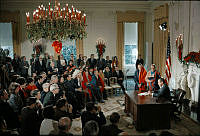Emigrant Scene, White House Collection
This painting is attributed to William Henry Powell (sometimes known as W.H. Powell), who was a New York City painter and trained under Henry Inman. The painting depicts a group of settlers and their horses around a covered wagon. An American Indian man is in the center of the group and pointing off into the distance, suggesting he is providing directions to the seated figure looking at a map. Powell's "Discovery of the Mississippi by De Soto A.D. 1541" hangs in the United States Capitol Rotunda.
























